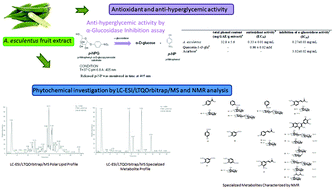Okra fruit: LC-ESI/LTQOrbitrap/MS/MSn based deep insight on polar lipids and specialized metabolites with evaluation of anti-oxidant and anti-hyperglycemic activity
Abstract
Okra is a vegetable crop very popular in tropical, subtropical, and warm temperate regions of the world for its edible fruit. Nowadays, this species can be easily found in European local markets, as a basic ingredient in many local and traditional dishes. Considering the extensive and spread use of okra fruits, to achieve deep insight on its chemical composition the analysis of the polar extract by high-performance liquid chromatography coupled to multiple-stage linear ion-trap and orbitrap high-resolution mass spectrometry in negative electrospray ionization mode was carried out. By this approach, 39 metabolites belonging to different polar lipid classes, such as oxylipins, phospholipids, glycolipids, and sphingolipids, were putatively identified for the first time in A. esculentus. Moreover, LC-HRMS/MS analyses guided the isolation and characterization by NMR experiments of 19 specialized metabolites belonging to phenolic acid and flavonoid classes, 8 of them never reported before in A. esculentus. Finally, antioxidant activity and inhibition of α-glucosidase activity were assayed, suggesting a good anti-oxidant anti-hyperglycemic activity for okra fruit.



 Please wait while we load your content...
Please wait while we load your content...